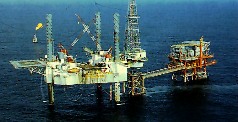The research game plan, exploring ever-deeper
waters, talking to the big fish and the little fish
Oil production in Angola is largely based offshore (see
map) and has been progressively moving
from shallower waters to deep-water production and now to ultra-deep-water
production.
Dr. Sylvia Earle, a renowned marine biologist, once said that
we know more about space than we do the depths of the ocean.
Determining the impact of oil production on these unknown depths
is nearly impossible, so taking the proper precautions to mitigate
any negative impacts is imperative.
The government has recently enacted many strict regulations
to ensure that the rich fisheries and marine life attributed
to the Benguela current running northward along the Angolan
coast are not negatively affected. For example, when the Ministry
of Fisheries determined that seismic operations related to
oil exploration activities could interfere with sea turtle
migrations, the ministry prohibited seismic activities during
the migration period. Operating companies have been ordered
to phase out over the next few years the practice of flaring
associated with natural gas, a significant form of environmental
pollution. The government has also assessed oil companies
large penalties for spills or leaks.
Apart from studying the techniques of production and the regulations
imposed, discovering what local people know is vital in assessing
the oil industry's impact. Do the people feel that their resources
are affected? Are their livelihoods affected? What have the
developments been over time? And what are the social impacts
of production? How do local people see the developments in
offshore oil production? Are they benefiting from corporate
social responsibility projects or a share of the production
profits?
The first half of my research plan involves speaking with
persons in Luanda: international and local non-governmental
organizations (NGOs), government officials from the Ministry
of Petroleum, the Ministry of Environment and the Ministry
of Fisheries, representatives of the national oil company
(SONANGOL) and affiliates of the four main oil multinational
companies operating in Angola: BP-Amoco, TotalFinaElf, ChevronTexaco
and ExxonMobil. I will ask members of these groups questions
ranging from the issue of environmental regulations to the
topic of corporate social responsibility projects.
During the second half of my research project, I will travel
to the oil producing areas of Soyo and Cabinda. Here, I hope
to make contact with locals through community groups, municipal
organizations and fishing associations suggested by the NGOs
based in Luanda. I am told that the climate of suspicion is
even greater in the provincial areas than in Luanda. Establishing
relationships of trust and openness here, onshore of the oil-producing
areas, will be a must for me.
— Kristin



